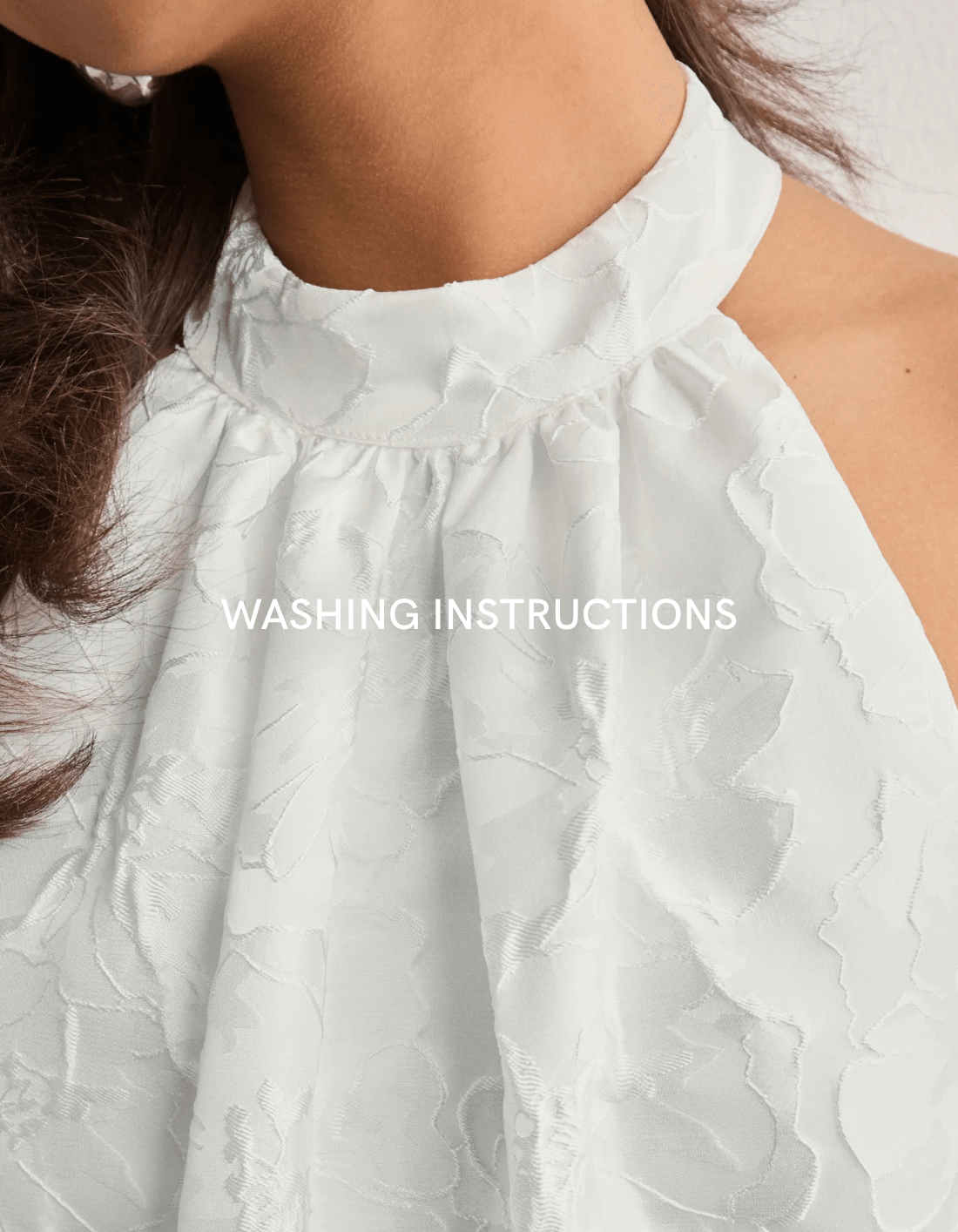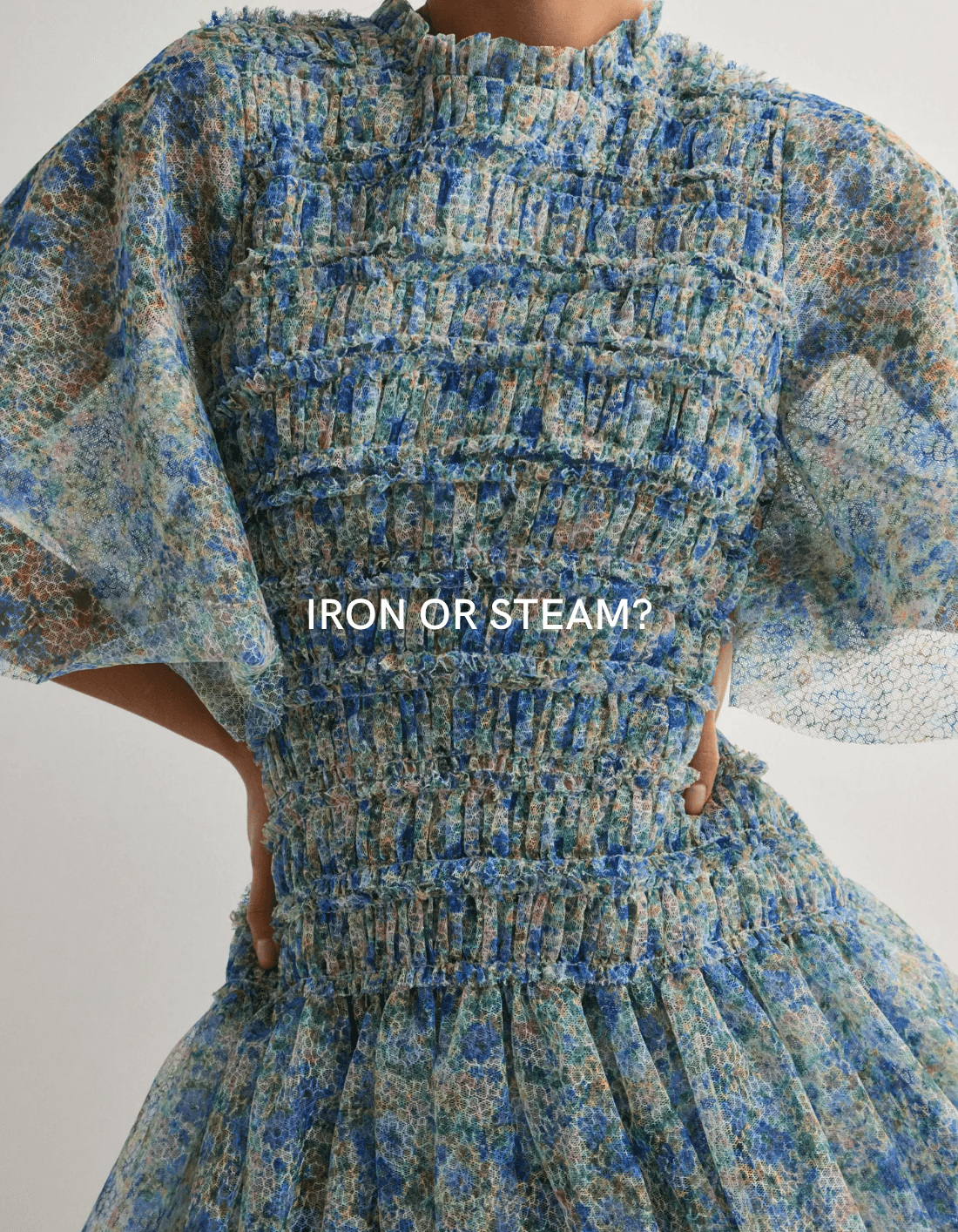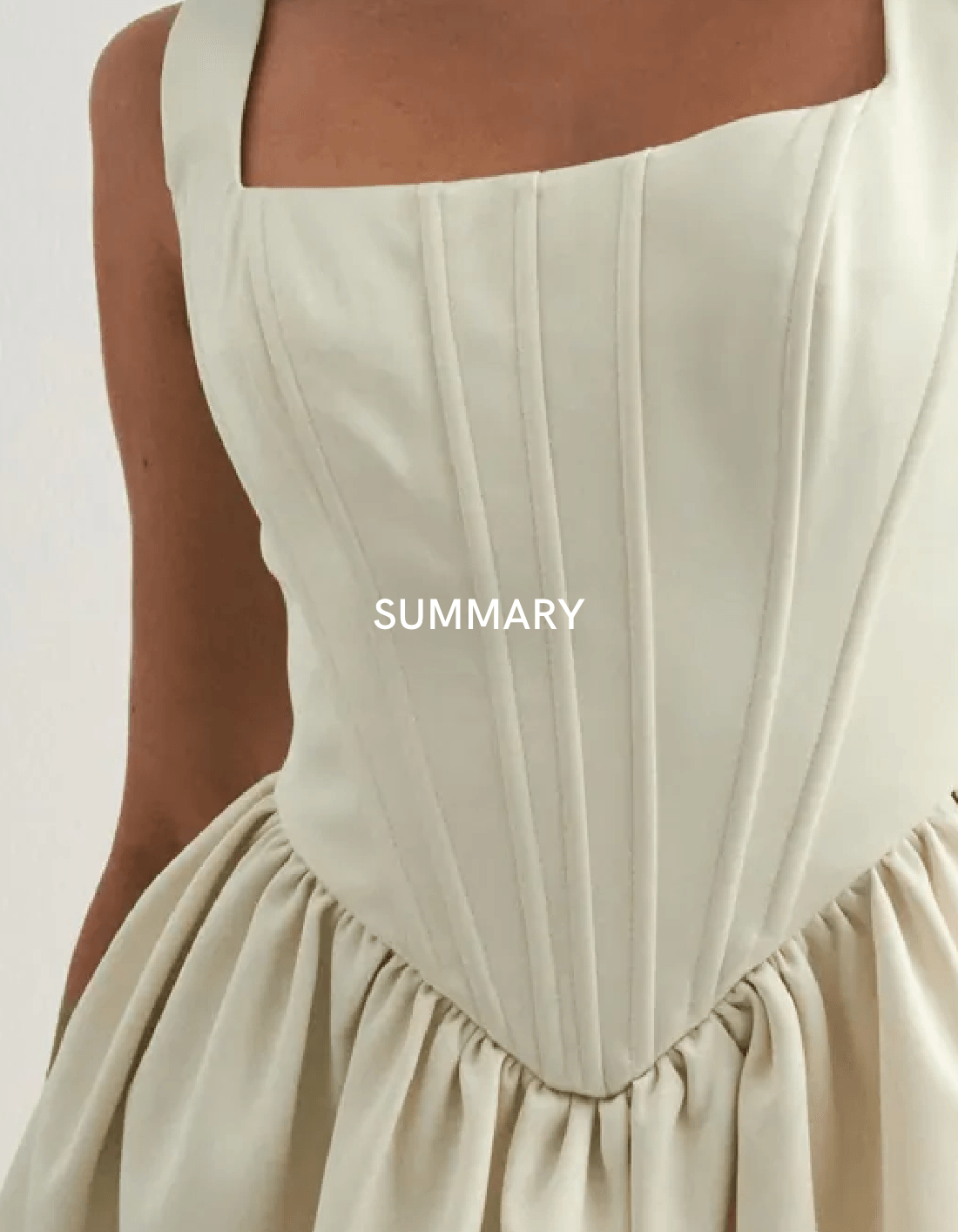CARE TIPS FOR YOUR DRESSES
- If you care for your clothes properly, they last longer – and you get more value out of every purchase. Here’s a practical guide on how to wash and handle your dresses to help them maintain both shape and color for as long as possible.
USE THE CARE LABEL
It may seem obvious, but the care label is important. That’s where you’ll find all the information about how to wash, dry, and iron the garment. A tip is to take a photo of the symbols on the care label if you plan to cut it off – it's easy to forget them.
What do the symbols mean?
Washing Temperature
Symbol: A tub with a number (e.g., 30, 40, or 60). The number indicates the maximum recommended temperature. High heat can damage delicate fabrics, while temperatures that are too low may make tough stains harder to remove.
Hand Wash
Symbol: A hand in a tub. The garment is extra delicate and should ideally be hand-washed using gentle movements and low temperature.
Do Not Tumble Dry
Symbol: A tumble dryer with a cross over it. Some materials shrink or lose shape in the dryer. Air dry instead.
Ironing
Symbol: An iron with dots (1–3). More dots mean the garment can withstand higher heat. One dot = low heat, three dots = high heat.
Dry Cleaning
Symbol: A circle with a letter (often P or F). This means the garment should be dry cleaned or handled by a professional to avoid damage.
WASHING INSTRUCTIONS
Learn to sort laundry
Different colors and materials require different care. Always start by separating:
- Light-colored laundry
- Dark-colored laundry
- Colored items (red, pink, yellow, etc.)
- Delicate materials – such as lace, silk, or sequins. These may need separate washing or special care.
Turn the dress inside out
Turn the dress inside out before washing. This protects the color, prints, and any details. It’s especially important if the garment has sequins, embroidery, or other embellishments.
Use a laundry bag for delicate garments
Lace, mesh, and thin straps can easily get caught on zippers or other clothes. A laundry bag reduces the risk of damage and helps the dress maintain its shape longer.
The right detergent makes a difference
- Color detergent – for colored dresses. Helps preserve the color.
- White detergent – for white garments you want to keep bright.
- Delicate detergent – for fragile materials.
Avoid fabric softener on garments with lots of stretch – it can reduce elasticity over time. For cotton dresses, it may work, but always double-check the care label first.
Temperature: moderate is best
Most detergents work well at 30 or 40 degrees Celsius. It saves energy and is gentle on the garment. For heavily soiled dresses or tough stains, you can go up to 60 degrees – but only if the care instructions allow it.
Hand wash for the most delicate dresses
Some dresses are simply too fragile for the machine. Hand washing takes a bit more time but is often the best option.
- Fill a basin or sink with lukewarm water.
- Add mild detergent and stir gently.
- Rinse thoroughly with cold water until all detergent is gone.
- Gently press out the water (do not wring).
- Lay on a towel and roll gently to draw out excess water, or lay flat to dry.
Tip: Do you have sensitive skin? Use rubber gloves when hand washing.
SKIP THE TUMBLE DRYER
The tumble dryer may be fast, but it's often an enemy to dresses. The heat and intense motion in the dryer can cause shrinkage, pilling, and wear on the fabric.
Best ways to dry dresses:
- Flat Drying: Perfect for knitted dresses and heavier garments that may lose their shape in the dryer. Lay the dress flat on a dry towel or drying rack at an even level. This helps preserve both the fit and texture.
- Hanging: Most woven dresses—such as those made from cotton, linen, or polyester—can be hung on a hanger. Keep in mind that wet fabric can stretch if it's too heavy. Hang the dress in a place where it won’t risk being stretched out.
- Avoid Direct Sunlight: Strong sunlight can fade colors and create uneven marks. To preserve both color and fabric quality, hang the dress in the shade or indoors near a well-ventilated window.
HANG OR FOLD?
Once the dress is clean and dry, you naturally want it to stay fresh until next time. How you store it plays a big role in preserving both its shape and longevity.
Which dresses should be hung?
- Woven fabrics: Dresses made from materials like cotton, polyester, or shirt dresses should be hung to maintain their shape and prevent wrinkles.
- Dresses with few or no heavy embellishments: These garments aren’t at risk of being deformed by their own weight and do well when hung.
- The right hanger matters: To avoid unsightly shoulder marks, choose a hanger with shaped or padded edges.
Which dresses should be folded?
- Knitted or crocheted dresses: These can easily stretch out if hung for too long, so folding is better for maintaining their shape.
- Heavy materials: Dresses made from heavier fabrics may deform at the shoulders if hung, so they should be folded instead.
- Delicate details: Dresses with sequins, lace, or embroidery can snag on other garments if hung, so folding is a safer option to avoid damage.
Long-term storage
If you have seasonal items (like a summery beach dress that isn’t used in winter), store them in a clean box or garment bag. Make sure the dresses are completely dry and clean before putting them away to avoid unpleasant odors or stains that can set over time.
IRON OR STEAM?
A wrinkle-free dress always looks more polished. But not all fabrics can handle the high heat of an iron, and sometimes you want to preserve the shape, ruffles, or pleats without flattening them. Here are the advantages of steaming versus ironing.
Advantages of a steamer
- Gentle: A steamer avoids direct contact between the garment and a hot iron plate, making it much gentler on delicate materials.
- Quick: Perfect when you're in a hurry and need to remove wrinkles fast, without setting up an iron.
- Versatile: A steamer works on most fabrics, including delicate ones like silk, synthetics, and pleated garments that could be damaged by direct heat.
When you need an iron
- Cotton, linen, and some synthetics: These materials often require higher heat to become completely smooth.
- Correct temperature: Always read the care label to ensure the right setting. An iron with adjustable temperature (and preferably a steam function) makes the job easier and safer.
- Use a pressing cloth: If you're unsure whether the fabric can handle high heat, place a thin cloth or piece of cotton fabric between the iron and the garment to prevent shiny marks or burns.
Tip: If you don’t have a steamer, hang the dress in the bathroom while taking a hot shower. The steam can help relax some wrinkles on fabrics that can't tolerate direct heat.
HOW TO CARE FOR DIFFERENT FABRICS
Dresses on Nelly.com come in many materials – from breezy cotton dresses to party dresses with sequins. Each fabric has its own characteristics, so here’s a quick guide on how to wash and care for them:
Cotton & Linen
Characteristics: Natural materials that breathe well. Cotton is durable; linen is more delicate and prone to wrinkling.
Washing: Usually machine washable at 40 °C, but always double-check the care label.
Aftercare: Cotton can be ironed at high heat. Linen wrinkles easily – a steamer can give a smoother result.
Polyester & Synthetic Materials
Characteristics: Easy to care for, rarely wrinkles, dries quickly.
Washing: 30–40 °C is usually enough. Avoid high heat – both when washing and drying.
Common issue: Static electricity. Anti-static spray or a mild fabric softener (if allowed) can help.
Viscose, Modal & Lyocell
Characteristics: Soft, drapey fabrics that feel cool against the skin.
Washing: Fragile when wet and prone to shrinking. Use a delicate cycle at 30 °C. Some garments may require hand washing.
Aftercare: Reshape the garment while damp. These materials can change shape depending on how they’re handled after washing.
Silk & Satin
Characteristics: Thin, shiny, and luxurious materials that require gentle care.
Washing: Many silk garments require dry cleaning or hand washing with a mild detergent.
Tips: Do not wring. Roll the garment in a towel to gently press out water. Iron or steam at low heat, preferably with a pressing cloth in between.
Lace & Mesh
Characteristics: Sheer and delicate fabrics that are easily damaged.
Washing: Use a laundry bag and a gentle cycle – or hand wash.
Aftercare: Do not pull on the fabric when wet. Lay flat to dry or hang carefully without stretching.
Sequins, Beads & Embellishments
Characteristics: Decorative details often sewn or glued on. Sensitive to both water and machine movement.
Washing: Turn the garment inside out, use a laundry bag, or hand wash if possible. Many embellished garments should be dry cleaned.
Stains: Spot clean gently if needed. Avoid rubbing or soaking the entire garment unless absolutely necessary.
HOW TO DEAL WITH STAINS
Stains happen to all of us, but with the right care, you can save your dress.
Common stains and how to remove them:
- Makeup stains (lipstick, foundation): Gently dab with a little liquid soap or dishwashing detergent mixed with lukewarm water. Don’t rub—it can spread the stain or damage the fabric. An alternative is to use micellar water, which is both gentle and effective.
- Greasy food (oil, butter, sauce): Sprinkle potato starch, cornstarch, or baby powder over the stain to absorb the grease. Gently brush off the powder, then treat with dish soap to remove the residue.
- Wine, coffee, or tea: Rinse the stain immediately with cold water—preferably from the back side of the fabric. Apply a mild detergent or stain remover to help break down the stain.
- Blood: Use cold water to rinse out the blood. Warm water will cause the blood to coagulate and set in. You can also add a bit of dish soap or salt to help dissolve the stain faster.
Gall soap for stubborn stains:
Gall soap, made with ox bile, is an effective and gentle option for fatty or protein-based stains like blood or food grease. Wet the stain and the soap, gently massage it in, and let it sit for a few minutes. Rinse thoroughly with lukewarm water or wash normally, depending on the garment's care instructions. Always test on a small hidden area first, especially if the fabric is delicate.
When should you consider dry cleaning or professional help?
If your garment has a “Dry Clean Only” label, or if the stain is particularly tough (such as paint, heavy discoloration, or tar), it’s best to contact a professional cleaner. They have the right products and expertise to remove stains without damaging the fabric.
Tip: For unwanted odors, like smoke or sweat, try hanging the dress outside in fresh air. Often, that’s enough to eliminate the smell without needing to wash the entire garment.
SMALL FIXES MAKE A BIG DIFFERENCE
We’ve all been there – a button falls off just before the party, or a seam comes undone in a rush. Knowing how to make a simple repair can really extend the life of your favorite dresses and save them from becoming unwearable.
Sewing on a button
1. Thread a needle with thread in a color that matches the garment.
2. Push the needle through the inside of the fabric and through one of the buttonholes. Pull through and repeat several times per hole to ensure the button is securely attached.
3. Tie off the thread on the inside of the garment with a small knot.
Repairing a seam
1. If you notice a side seam or hem starting to come apart, grab a needle and thread.
2. Use a simple straight stitch or zigzag stitch, depending on the area, and sew along the tear until it’s securely closed.
3. Tie off the thread firmly when you're done.
Even if you’re unsure, there are plenty of helpful videos online that show you step-by-step how to sew on a button or fix a seam. Give it a try – it’s actually easier than you think and can save both your dresses and your wallet!
GARMENT CARE = SUSTAINABLE FASHION
Taking care of our clothes isn’t just about budget or style – it’s also an important part of sustainable thinking.
When you care for your dress properly:
- You reduce environmental impact by extending the garment’s lifespan and avoiding unnecessary resource consumption.
- You save money by not having to replace items that have been damaged or worn out.
- You invest in your style – it’s more satisfying to wear clothes that feel just as fresh and fashionable season after season.
By choosing the right care methods, washing smart, and storing your garments thoughtfully, you’re doing something good for both yourself and the planet.
SUMMARY
You now have a complete toolkit of tips on how to best care for your dresses from NELLY. Here are the key points to keep in mind:
- Read the care label (or take a photo of it for easy reference)
- Sort properly, turn garments inside out, and use gentle wash cycles
- Choose the right detergent and adjust the temperature to suit the fabric
- Avoid the tumble dryer when possible – let dresses air dry gently
- Steam or iron when needed, but be cautious with heat
- Store your dresses smartly to extend their lifespan
- Small repairs can make a big difference in keeping your favorite items intact
- Gall soap is an effective solution for stubborn stains
Washing and caring for your clothes doesn’t have to be a chore. Think of it as an investment in your wardrobe.











